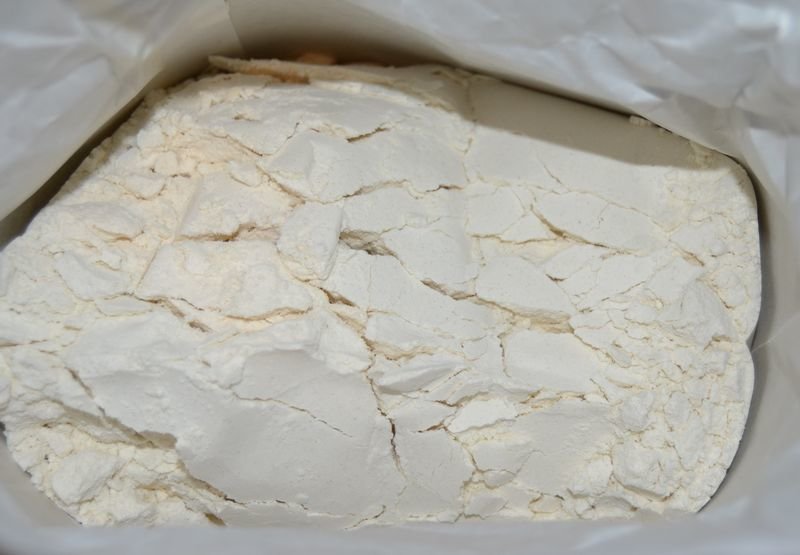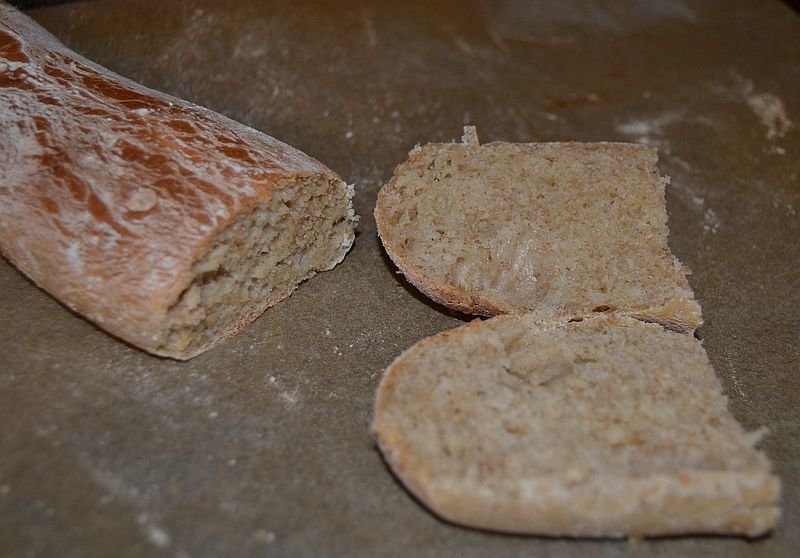Bread, that magical thing, which is so nice when you get it right and while it bloats it does so good.
I have made my variation of this King Arthur's recipe, mostly because there is no semolina here, only semolina is white stuff for breakfast use and that is not correct type, durum flour is closest thing we have and even that I have to get from city which is 2 hour ride:
http://www.kingarthurflour.com/recipes/italian-hearth-bread-recipe
Medium grind wheat flour 298g
Durum wheat flour 41g
whole wheat flour 20,5g
yeast bread flour (I don't know English name) 20,5g
Water 255g
Olive oil 25g
Sugar 5g
Salt 6,25g
Yeast (dry)5,66g
First, add water and sugar in mixer bowl, warm it to 37-38C (I know they say for dry yeast it should be 42C, it is not true, staying below 40C gives me 100% success in rising bread, while 42C randomly fails the yeast), add yeast and 30g of flour, mix with medium until little foam appears, then let it sit for few minutes as that is starter.
After it is foamy thick stuff, add rest of flour, salt and olive oil, mix in mixer for 2 minutes at low speed.
Let it rest 15 minutes.
Mix 7 minutes at low speed, after that put bowl to warm spot, cover with plastic, let it rise for 1 hour.
After 1 hour make it bread shaped, put to oven pan, sprinkle flour on top of it and rub very gently some flour on top of bread, then put baking sheet on top and plastic on top of that, let it rise for 1 hour at non draft bit warmer than room temp location.
Baking at bottom most position in the oven that is warmed to 200C, 15-20 minutes, dark brown means it was too long, it should be quite light.
It came out wonderfully, perfect bread, perfect resistance, perfect taste.
That was 1/2 batch size, next I decided to make full amount, so doubled everything.
Medium grind wheat flour 596g
Durum wheat flour 82g
whole wheat flour 41g
yeast bread flour (I don't know English name) 41g
Water 510g
Olive oil 50g
Sugar 10g
Salt 12g
Yeast (dry) 11g
Dough was way too loose, I ended up adding almost 100g of flour and dough still was quite loose, very sticky, but somewhat manageable, taste was good, texture was good, only thing was that it was too loose as bread did rise, but more of sideways.
I'm bit puzzled about how increasing size ended up dough being so much different, I weight everything carefully, clock times and check that temperatures of my cooking are to match, trying to eliminate all the variables which has improved results incredibly, but now all of sudden I get dough that is way too loose and I should have same proportions, same temperatures, same timing and it was less than 24 hours apart from 1st to 2nd attempt.
Anyone has experienced such things before?
Oh, bread works really well with tuna, it has quite bit stronger taste than one baked just from all purpose wheat flour.
Also I have done same recipe with less yeast in such way that at evening I have prepared the dough and put it to cold, let it rise for more than 8 hours, not much difference to taste, but it was too fluffy from inside, no resistance at all, also for some odd reason crust became very hard which was unexplainable also.
I start to doubt my scale, could it lie randomly like bathroom scale does, especially after that extra bit of bread? :lol3:
I have made my variation of this King Arthur's recipe, mostly because there is no semolina here, only semolina is white stuff for breakfast use and that is not correct type, durum flour is closest thing we have and even that I have to get from city which is 2 hour ride:
http://www.kingarthurflour.com/recipes/italian-hearth-bread-recipe
Medium grind wheat flour 298g
Durum wheat flour 41g
whole wheat flour 20,5g
yeast bread flour (I don't know English name) 20,5g
Water 255g
Olive oil 25g
Sugar 5g
Salt 6,25g
Yeast (dry)5,66g
First, add water and sugar in mixer bowl, warm it to 37-38C (I know they say for dry yeast it should be 42C, it is not true, staying below 40C gives me 100% success in rising bread, while 42C randomly fails the yeast), add yeast and 30g of flour, mix with medium until little foam appears, then let it sit for few minutes as that is starter.
After it is foamy thick stuff, add rest of flour, salt and olive oil, mix in mixer for 2 minutes at low speed.
Let it rest 15 minutes.
Mix 7 minutes at low speed, after that put bowl to warm spot, cover with plastic, let it rise for 1 hour.
After 1 hour make it bread shaped, put to oven pan, sprinkle flour on top of it and rub very gently some flour on top of bread, then put baking sheet on top and plastic on top of that, let it rise for 1 hour at non draft bit warmer than room temp location.
Baking at bottom most position in the oven that is warmed to 200C, 15-20 minutes, dark brown means it was too long, it should be quite light.
It came out wonderfully, perfect bread, perfect resistance, perfect taste.
That was 1/2 batch size, next I decided to make full amount, so doubled everything.
Medium grind wheat flour 596g
Durum wheat flour 82g
whole wheat flour 41g
yeast bread flour (I don't know English name) 41g
Water 510g
Olive oil 50g
Sugar 10g
Salt 12g
Yeast (dry) 11g
Dough was way too loose, I ended up adding almost 100g of flour and dough still was quite loose, very sticky, but somewhat manageable, taste was good, texture was good, only thing was that it was too loose as bread did rise, but more of sideways.
I'm bit puzzled about how increasing size ended up dough being so much different, I weight everything carefully, clock times and check that temperatures of my cooking are to match, trying to eliminate all the variables which has improved results incredibly, but now all of sudden I get dough that is way too loose and I should have same proportions, same temperatures, same timing and it was less than 24 hours apart from 1st to 2nd attempt.
Anyone has experienced such things before?
Oh, bread works really well with tuna, it has quite bit stronger taste than one baked just from all purpose wheat flour.
Also I have done same recipe with less yeast in such way that at evening I have prepared the dough and put it to cold, let it rise for more than 8 hours, not much difference to taste, but it was too fluffy from inside, no resistance at all, also for some odd reason crust became very hard which was unexplainable also.
I start to doubt my scale, could it lie randomly like bathroom scale does, especially after that extra bit of bread? :lol3:

















